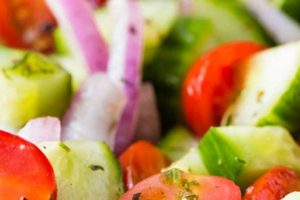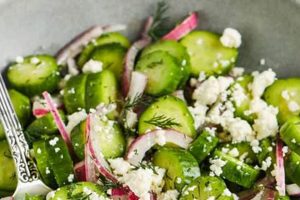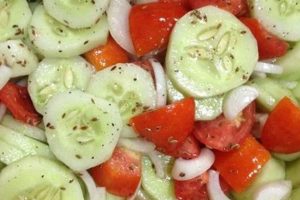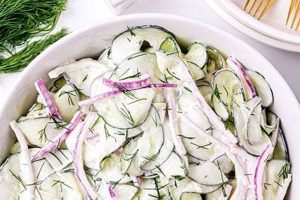This refreshing and flavorful dish typically combines thinly sliced cucumbers with a vibrant blend of gochugaru (Korean chili flakes), garlic, ginger, sesame oil, rice vinegar, and often a touch of sweetness. Variations may include scallions, onions, or other aromatics. A simple preparation, it delivers a complex flavor profile, balancing heat, tanginess, and umami. It can be served as a banchan (side dish) or a light salad.
The dish offers a healthy and low-calorie option, contributing vitamins, minerals, and hydration from the cucumbers. The fermentation process, sometimes employed, can further enhance its nutritional value through probiotic benefits. Its prevalence in Korean cuisine reflects both its culinary versatility and its contribution to a balanced meal. Historically, preservation techniques, such as pickling and fermenting, played an essential role in Korean food culture, influencing the development of this and similar preparations.
Further exploration will delve into variations, detailed preparation instructions, nutritional information, and suggested pairings to enhance the culinary experience. This foundation provides context for understanding its unique characteristics and appreciating its role within a wider culinary landscape.
Tips for an Exceptional Cucumber Salad
Achieving optimal flavor and texture requires attention to detail. These guidelines offer insights into preparation techniques and ingredient selection.
Tip 1: Cucumber Preparation: Thinly slicing cucumbers ensures even flavor distribution and a pleasant texture. Mandolines create uniform slices, but a sharp knife can also achieve excellent results. Salting the cucumbers and allowing them to drain draws out excess moisture, preventing a watery salad.
Tip 2: Gochugaru Selection: Korean chili flakes (gochugaru) contribute the characteristic heat. Fine flakes blend seamlessly into the sauce, while coarser flakes provide texture. Experimenting with different levels of gochugaru allows for customized spice levels.
Tip 3: Balancing Flavors: The interplay of sweet, sour, spicy, and savory components creates a harmonious flavor profile. Rice vinegar provides tang, while a touch of sugar or honey adds sweetness. Adjusting these elements allows for personalized preferences.
Tip 4: Sesame Oil Enhancement: Toasted sesame oil imparts a rich, nutty aroma and flavor. A small quantity is sufficient to enhance the overall taste, avoiding an overpowering sesame flavor.
Tip 5: Aromatic Additions: Garlic and ginger form the aromatic foundation. Mincing or grating these ingredients releases their full flavor potential. Scallions or onions provide additional depth and texture.
Tip 6: Marinating Time: Allowing the salad to marinate for at least 30 minutes, or preferably longer, allows the flavors to meld and intensify. Chilling enhances the refreshing quality of the dish.
Tip 7: Serving Suggestions: This versatile dish complements various Korean meals. It serves as an excellent banchan (side dish) alongside grilled meats, rice, and other accompaniments. It can also stand alone as a light and refreshing salad.
By applying these techniques, one can elevate this simple dish to a culinary masterpiece, balancing flavors and textures for an authentic and enjoyable experience.
These practical tips offer a pathway to creating a memorable culinary experience, underscoring the nuances that transform simple ingredients into a harmonious dish.
1. Cucumbers (English, Persian)
Cucumber selection significantly influences the final flavor and texture of a spicy Korean cucumber salad. While various cucumber types exist, English and Persian cucumbers stand out as preferred choices due to their specific characteristics. Understanding these characteristics provides valuable insight into optimizing this culinary creation.
- Thin Skin and Minimal Seeds:
English and Persian cucumbers possess thin skins, eliminating the need for peeling. Their minimal seed content reduces excess moisture in the salad, contributing to a crisper texture and preventing dilution of the flavorful sauce. This characteristic distinguishes them from thicker-skinned, seed-heavy varieties less suitable for this application.
- Mild Flavor Profile:
The mild, subtly sweet flavor of these cucumbers allows the spicy, tangy, and savory components of the sauce to shine. Their neutrality avoids competing with the dominant flavors, creating a balanced and harmonious palate experience. This contrasts with stronger-flavored cucumbers that might clash with the intended flavor profile.
- Consistent Size and Shape:
The uniform size and shape of English and Persian cucumbers facilitate even slicing, ensuring consistent flavor distribution and a visually appealing presentation. This uniformity enhances both the aesthetic and culinary aspects of the dish, contributing to a more refined outcome. Irregularly shaped cucumbers pose challenges for achieving consistent slices.
- Availability and Accessibility:
These cucumber varieties are widely available in most markets, making them accessible for home cooks. Their accessibility contributes to the dish’s popularity and ease of preparation, making it a convenient yet flavorful culinary choice. Less common cucumber varieties might limit the dish’s accessibility.
The choice of English or Persian cucumbers underscores the importance of ingredient selection in achieving the desired balance of flavors and textures in a spicy Korean cucumber salad. Their unique attributes contribute significantly to the dish’s refreshing qualities, making them ideal components for this culinary creation. Selecting appropriate cucumbers forms the foundation for a successful and satisfying culinary experience.
2. Gochugaru (Korean Chili)
Gochugaru, a cornerstone of Korean cuisine, forms the foundation of the characteristic heat found in spicy Korean cucumber salad. This coarsely ground chili powder offers a complex flavor profile beyond mere spiciness, contributing fruity, smoky, and subtly sweet notes that distinguish it from other chili varieties. Its presence is essential for achieving the authentic flavor profile of this dish.
- Flavor Complexity:
Unlike generic chili powders, gochugaru possesses a multi-dimensional flavor profile. The drying process, often involving sun-drying, contributes to a distinctive depth of flavor that enhances the overall complexity of the cucumber salad. This complexity adds layers of flavor beyond simple heat.
- Variable Heat Levels:
Gochugaru is available in various heat levels, ranging from mild to extremely spicy. This variability allows for customization of the salad’s spiciness to suit individual preferences. Careful selection ensures the desired heat intensity without overwhelming the other flavors.
- Visual Appeal:
The vibrant red hue of gochugaru contributes to the dish’s visual appeal. The color intensity varies depending on the chili’s processing and origin, adding a vibrant element to the culinary presentation. This visual element enhances the overall dining experience.
- Cultural Significance:
Gochugaru’s integral role in Korean cuisine reflects its cultural significance. Its use in a wide range of dishes, including spicy cucumber salad, highlights its importance within Korean culinary traditions. Understanding this context adds depth to the culinary experience.
The nuanced flavors, variable heat levels, and cultural significance of gochugaru elevate spicy Korean cucumber salad beyond a simple side dish. It becomes a culinary expression of Korean flavors, showcasing the unique contributions of this essential ingredient. The careful selection and application of gochugaru contribute significantly to the dish’s authentic and vibrant character.
3. Garlic, ginger, aromatics
Garlic and ginger serve as foundational aromatics in spicy Korean cucumber salad, contributing significantly to its distinctive flavor profile. These pungent ingredients, common in many Asian cuisines, offer both flavor enhancement and potential health benefits. Their combined presence, along with other aromatic additions, creates a complex interplay that elevates the dish beyond simple refreshment. This intricate balance differentiates authentic preparations from less nuanced versions.
Garlic’s sharp, savory notes complement ginger’s warm, slightly sweet spiciness. This synergistic relationship enhances the other flavor components, such as the heat from gochugaru and the tanginess of vinegar. Beyond garlic and ginger, variations often incorporate other aromatics like scallions or onions, adding further depth and complexity. For example, the subtle sharpness of thinly sliced scallions provides a textural contrast and a mild onion flavor that complements the cucumbers. These additions, while optional, demonstrate the potential for customization and flavor layering within the basic recipe framework.
Understanding the role of garlic, ginger, and other aromatics in spicy Korean cucumber salad provides insight into the principles of flavor balance in Korean cuisine. It emphasizes the importance of fresh, high-quality ingredients and their careful preparation. Mince garlic and ginger finely to maximize their flavor release and ensure even distribution throughout the salad. This attention to detail elevates the dish from a simple side to a complex and flavorful component of a balanced meal. Mastering this balance allows for greater culinary creativity and appreciation of the nuances of flavor within Korean culinary traditions.
4. Vinegar (rice wine preferred)
Vinegar plays a crucial role in spicy Korean cucumber salad, providing the essential acidic element that balances the heat of gochugaru and the other flavors. While various vinegars can be utilized, rice wine vinegar stands out as the preferred choice due to its unique characteristics and its harmonious integration within the overall flavor profile.
- Mild Acidity and Subtle Sweetness:
Rice wine vinegar possesses a milder acidity compared to other vinegars, such as distilled white vinegar or apple cider vinegar. This mildness prevents an overly sharp or sour taste, allowing the other flavors, especially the gochugaru, to shine through. Additionally, its subtle sweetness complements the other ingredients, creating a balanced and harmonious flavor profile.
- Enhancing Flavor Complexity:
Rice wine vinegar contributes to the overall complexity of the dish. Its nuanced flavor profile, often described as slightly sweet and subtly fruity, adds depth and dimension to the salad. This complexity enhances the interplay of spicy, sweet, and savory elements.
- Cultural Relevance:
Rice wine vinegar holds a prominent place in East Asian cuisines, including Korean cuisine. Its use in this salad reflects its traditional role in balancing flavors and enhancing the overall culinary experience. This cultural context reinforces the authenticity of the dish.
- Accessibility and Availability:
Rice wine vinegar is readily available in most grocery stores, making it a convenient choice for home cooks. Its widespread availability contributes to the ease of preparing spicy Korean cucumber salad, allowing for broader accessibility to this culinary tradition.
The selection of rice wine vinegar as the preferred acidic component underscores its importance in achieving the desired balance of flavors in spicy Korean cucumber salad. Its mild acidity, subtle sweetness, and cultural relevance contribute significantly to the dish’s authentic character and refreshing qualities, making it an integral part of this culinary experience. While other vinegars can be substituted, they may not replicate the nuanced flavor profile that rice wine vinegar provides, potentially altering the overall balance and authenticity of the dish.
5. Sesame Oil, Soy Sauce
Sesame oil and soy sauce contribute essential savory and umami notes to spicy Korean cucumber salad, enhancing the complexity of the dish. While seemingly simple ingredients, their selection and application significantly influence the final flavor profile. Understanding their individual characteristics and combined effect provides a deeper appreciation for their role in this culinary creation.
- Sesame Oil’s Aromatic Impact:
Toasted sesame oil delivers a rich, nutty aroma and flavor that complements the other ingredients. Even a small amount significantly enhances the salad’s sensory experience. Untoasted sesame oil lacks this distinct roasted flavor, making the toasted variety essential for achieving the desired complexity. Overuse can overwhelm the delicate balance, so judicious application is crucial.
- Soy Sauce’s Umami Contribution:
Soy sauce provides a salty, umami-rich base that enhances the overall savoriness. It deepens the flavor profile and complements the spiciness of the gochugaru. Different types of soy sauce, such as light, dark, or tamari, offer varying levels of saltiness and umami, allowing for nuanced adjustments to the final flavor.
- Synergistic Flavor Enhancement:
The combination of sesame oil and soy sauce creates a synergistic effect, amplifying their individual contributions. The nutty aroma of sesame oil intertwines with the savory depth of soy sauce, creating a harmonious blend that elevates the overall taste. This combined effect is essential for achieving the characteristic flavor profile of the dish.
- Balancing Act:
Achieving the proper balance between sesame oil, soy sauce, and other ingredients is crucial. Too much soy sauce can make the salad overly salty, while excessive sesame oil can overpower the other flavors. Careful measurement and tasting throughout the preparation process ensure a harmonious balance, allowing each ingredient to contribute without dominating.
The combined presence of sesame oil and soy sauce significantly contributes to the overall balance and complexity of spicy Korean cucumber salad. Their careful application enhances the interplay of spicy, tangy, and savory elements, resulting in a dish that is both refreshing and deeply flavorful. Understanding their individual characteristics and combined impact allows for a greater appreciation of their role in this culinary creation and provides a foundation for achieving an authentic and delicious outcome.
6. Sweetener (sugar or honey)
Sweetener, typically sugar or honey, plays a crucial, albeit often subtle, role in spicy Korean cucumber salad. Its presence is not merely to add sweetness; it functions as a critical balancing agent, mitigating the sharp acidity of the vinegar and the fiery heat of the gochugaru. This balancing act creates a more harmonious flavor profile, preventing the dish from becoming overly sour or spicy. Furthermore, the sweetener enhances the overall complexity, contributing a subtle depth that rounds out the other flavors. The choice between sugar and honey influences the final nuanced taste. Granulated sugar provides a clean sweetness, while honey introduces subtle floral and caramel notes.
Consider the interplay of flavors: the sharp tang of rice vinegar, the pungent heat of gochugaru, the savory umami of soy sauce, and the fresh, slightly bitter taste of cucumber. Without a sweetener, these elements could clash, resulting in a dish that is unbalanced and potentially jarring to the palate. The addition of sugar or honey smooths out these rough edges, allowing the individual flavors to meld harmoniously. For instance, a spicy cucumber salad made with only vinegar and gochugaru might taste overly sharp and aggressively spicy. However, incorporating a teaspoon of sugar tempers the heat and acidity, allowing the complexity of the gochugaru to emerge. Similarly, honey’s subtle floral notes can complement the cucumber’s freshness, adding another layer of complexity to the overall flavor profile.
Understanding the function of sweetener in this context underscores the importance of balanced flavors in Korean cuisine. It’s not simply about adding sweet to counter spicy or sour; it’s about achieving a harmonious interplay of all the ingredients. This principle extends beyond spicy cucumber salad, reflecting a broader culinary philosophy that emphasizes balance and complexity. Practical application requires careful consideration of the desired level of sweetness and the potential influence of the chosen sweetener on the overall flavor profile. Over-sweetening can mask the other flavors, while too little can leave the dish unbalanced. Experimentation and careful tasting are crucial for achieving the optimal balance, tailoring the recipe to individual preferences while maintaining the dish’s authentic character.
Frequently Asked Questions
This section addresses common inquiries regarding the preparation and variations of this dish, providing clarity and guidance for achieving optimal results.
Question 1: Can other types of chili flakes be substituted for gochugaru?
While other chili flakes can be used, they may not fully replicate gochugaru’s unique flavor profile. Gochugaru possesses a distinct smoky sweetness and depth of flavor that contributes significantly to the dish’s authenticity. Substitutions might result in a different flavor profile.
Question 2: How long can the salad be stored?
Refrigerated in an airtight container, the salad can typically be stored for up to 3 days. Flavor intensity may increase over time as the ingredients meld. However, the cucumbers’ texture might soften slightly with extended storage.
Question 3: What are some variations on the basic recipe?
Variations include incorporating sesame seeds, fish sauce, different types of vinegar, or additional vegetables like carrots or onions. These additions can further enhance the flavor profile and textural complexity, offering opportunities for customization based on individual preferences.
Question 4: Is it necessary to salt the cucumbers before preparing the salad?
Salting the cucumbers draws out excess moisture, resulting in a crispier texture and preventing a watery salad. While not strictly necessary, this step significantly improves the final result, especially when using cucumbers with higher water content.
Question 5: Can this salad be made ahead of time for a large gathering?
Preparing the salad a few hours in advance allows the flavors to meld. However, adding the cucumbers just before serving preserves their crisp texture and prevents them from becoming soggy. This approach balances flavor development and optimal texture.
Question 6: Are there any health benefits associated with this dish?
Cucumbers provide hydration and essential vitamins and minerals. Gochugaru offers potential antioxidant benefits. However, the overall nutritional value depends on the specific ingredients and portion sizes. This dish generally contributes to a healthy and balanced diet.
Careful consideration of these frequently asked questions ensures successful preparation and a deeper understanding of this dish’s nuances. Addressing these common inquiries clarifies potential challenges and provides guidance for achieving optimal results.
The following sections delve further into specific aspects of this culinary creation, offering detailed insights and practical tips for enhancing the overall experience.
Spicy Korean Cucumber Salad Recipe
This exploration of spicy Korean cucumber salad recipes has illuminated the dish’s multifaceted nature, from its historical context and cultural significance to the nuanced interplay of flavors and textures. Key elements, including the selection of cucumbers, the specific characteristics of gochugaru, the aromatic foundation of garlic and ginger, the balancing role of vinegar and sweeteners, and the enriching contributions of sesame oil and soy sauce, have been examined in detail. Preparation techniques, variations, and common inquiries have also been addressed, providing a comprehensive understanding of this culinary creation.
Spicy Korean cucumber salad stands as a testament to the power of simple ingredients transformed through culinary artistry. Its enduring presence in Korean cuisine reflects not only its refreshing and flavorful nature but also its embodiment of fundamental culinary principles: balance, harmony, and the transformative potential of carefully selected ingredients. Further exploration and experimentation within the provided framework promise an enriching culinary journey and a deeper appreciation of Korean gastronomic traditions.






